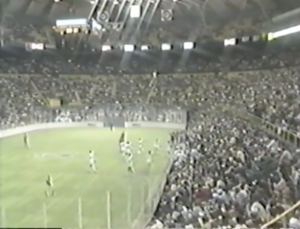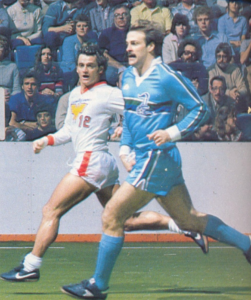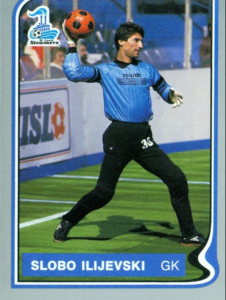Happy Blog Day, everyone. It’s great to be back in (insert city) with you, and thanks for coming out. T-shirts are on sale in the lobby, and remember to tip your bartenders and waitresses. We’re going to finish up with one last hit, called “Human Pinball.” It goes a little something like this… (raucous applause and a standing ovation).
“Bats, Balls, & Burnouts” is into the final stage for approval, so I’m still diligently waiting for galley proof No. 2 to come bouncing back home to me. I’m like totally focused on waiting. Patiently. In the meantime, it struck me that in this blog I’ve often referenced the sport that is represented by the ball I’m holding on the book’s cover, and the word that comes between “Bats” and “Burnouts.” Yes, it’s soccer, but it’s a different kind of soccer that many (most?) of you have probably never seen, and maybe never heard of, at least from any source other than me. It’s indoor soccer, and it was a big part of my life. Hence its inclusion in the title and the photo.
Soccer has been played indoors almost forever, of course, but usually for training sessions or in the version called futsal in places where soccer is so popular it can be supported in various versions. In futsal, the indoor floor is really just a shrunken version of an outdoor field (picture soccer on a basketball court) the ball is slightly smaller, and the “field” is generally a hard/smooth surface. The ball goes out of bounds a lot. Like all the time.
In the late 70s, two businessmen who were also sports guys saw an indoor exhibition soccer game played on a hockey rink covered in Astroturf. They were so excited by it, they created a sport. Their names were Earl Foreman and Ed Tepper. The sport they created was a version of indoor soccer much like the exhibition they saw, but they mapped it out, created a league, and established the official rules. They even figured out that a red ball, on a green field, would show up best on television.
They launched the Major Indoor Soccer League (MISL) in late 1978, planning for it to be a winter sport at the time of year when indoor activities are at a premium. They started with six teams: The New York Arrows, Philadelphia Fever, Cleveland Force, Houston Summit, Pittsburgh Spirit, and Cincinnati Kids. If you were a fan of the great TV show “WKRP In Cincinnati” you might even recall an early episode in which a Kids player of British descent gets interviewed on the air and much hilarity ensues.
The concept was simple. Condense the game of soccer into the footprint of a hockey rink. Leave the boards and glass in place. Insert large soccer goals flush into the boards at each end. Hit the “delete” button on the outdoor offsides rule. All of that added up to this: Instead of the ball going out of bounds, it would usually rebound off the boards or glass and stay in play. If you took a shot and it went wide, the rebound would come straight back out. The game would cover the entire floor with few restrictions. Typical scores were 10-9 instead of 1-0. The MISL took off.
The flow was very different from the outdoor game. It was much more like hockey in every regard, including the fact the players would play shifts in a free-flow way, hopping over the boards to take the field when a teammate ran off. That allowed players to basically just sprint all the time, then take a quick break and do it again. The game never stopped moving at nearly full pace. There were two-minute penalties, as well, allowing one team to go on the power play when the other squad played a man short.
It was also mocked by just about everyone other than the fans who bought the tickets and loved it so much. There wasn’t a lot of “middle of the road” when it came to the new indoor version of “the beautiful game” and the way it was played was often referred to as “human pinball” by the naysayers. When the blocked shots and rebounds were careening all over the field, it could look a bit like pinball. With humans.
In 1979-80, the St. Louis Steamers came to my hometown. The Blues were not doing well then, and the fans were staying away in droves. St. Louis had no pro basketball team either, so there was a void to fill. Also, St. Louis was already a hotbed for soccer. It was the perfect formula.
More scoring than hockey. Lots of local boys and some popular foreigners. Smoke, strobe lights, and constant music. Plus dancing girls.

When the Steamers played their first game at the old St. Louis Arena (which at the time was called the Checkerdome because it and the Blues were owned by Ralston Purina after they saved the franchise for their home city) more than 18,000 people showed up to see the new sport and new team. The town basically went bonkers over the Steamers. They averaged 14,060 fans per game in their first year, then 15,219 in their second. In 1982-83, their third season, the Steamers packed in 17,107 per game, often selling standing-room-only tickets to draw crowds in excess of the Checkerdome’s capacity.
I remember those games like they were yesterday. Like most St. Louisans, I went nuts over the Steamers. The atmosphere at the games was completely electric. They had plenty of local guys, including a number who played their college soccer at SIU-Edwardsville at the same time I was playing baseball there. Guys like Don Ebert, Jeff Cacciatore, Greg Makowski, and Greg Villa. Villa and I have reconnected as friends on Facebook, in recent years.

With some other Americans on the team, as well, they filled in other key positions with some fabulous imports. Scotsman Tony Glavin was one of the most exciting players I’d ever seen. Irishman Redmond Lane was a fan favorite. But the biggest and most popular of them all was goalkeeper Slobo Ilijevski (pronounced, roughly, “Illy-evski”). He was Yugoslavian, and he’d come to America to play soccer but was down to his last few dollars when he tried out for the Steamers. He would become a St. Louis legend overnight.
And Slobo’s Yugoslavian heritage was not unique. For some reason, the indoor game seemed to be a natural fit for many Yugoslavs, and they became some of the sport’s biggest stars. Steve Zungul, Stan Stamenkovic, Mike Stankovic, Val Tuska, Nebo Bandovic, and many others were prodigious indoor soccer players.
Slobo was such a friendly guy, and with that thick Yugoslavian accent he was nothing less than charming. On the field, his acrobatic saves seemed impossible, and he had a tendency to dribble the ball up the field all by himself, leaving the goal empty. Those moments, when Slobo “wandered” up the field, kept the fans simultaneously enthralled and terrified. He was really something to watch.
I imagine I attended at least 50 Steamers games during the ’80s, and I even went and saw them once in San Francisco. The MISL was successful in many markets, but not all of them, and when it wasn’t good it was usually awful in terms of fan support. I spent one year living in Fresno, when I worked for the Toronto Blue Jays, and that was the winter the MISL came to the Bay Area. I went over to see the Steamers play the San Francisco Fog, at the Cow Palace near old Candlestick Park, and just about everything about the experience was counter to everything I knew at the Checkerdome.
I got there at around 6:45 for a 7:00 game, and parked right by the entrance. I went inside to watch and was joined by maybe 1,000 other humans. That optimistic total might have been true, if you counted the players, ushers, and vendors. San Francisco clearly didn’t take to the Fog. That would happen in other markets as well, while in St. Louis, Wichita, Kansas City, Cleveland, Dallas, San Diego, New York, and a few other markets, the game exploded with popularity.
The Steamers were so overwhelmingly popular they almost drove the Blues out of town. While the Blues were struggling to put big crowds in the building for hockey, the Steamers were filling the old barn to the rafters with SRO crowds. Finally, Ralston Purina had enough and they attempted to sell the team to a group in Saskatoon, but the NHL said, “No, actually, that won’t work.” So, Ralston simply gave the team back to the NHL. The Blues were just about to fold when the NHL finally found a new owner for both them and the building, which reverted back to its original name of the St. Louis Arena.

The MISL ebbed and flowed, with franchises coming and going while the mainstay teams continued on a strong successful course. Salaries were rising, though, and the initial group of team owners cashed out when the value was at its highest. Those folks made a lot of money. Those coming in behind them weren’t so fortunate. Even the Steamers weren’t immune, and after a couple of ownership changes they folded at the end of the 1988 season. It had been enormously fun while it lasted. A year later, a new expansion team came to town. I interviewed with their owner, Milan Mandaric (another Yugoslav) and was hired as Vice President – Marketing, for the upstart St. Louis Storm. I’d gone from being a fan to being a key part of a franchise, and I eagerly went to work each day in the same St. Louis Arena I had loved for so long. I wrote about it in great detail in the book. We even signed Slobo to be our goalkeeper. In 2008, while still playing the game he loved, Slobo died suddenly from a ruptured aorta. That was a tragically sad day in my life, and the lives of many others in the St. Louis area. He is truly missed.
I also was General Manager of the Kansas City Attack, in the National Professional Soccer League (NPSL), a new indoor league that took over from the MISL, and then for a brief period I ran the Indianapolis Twisters in yet another indoor league, the Continental Indoor Soccer League (CISL.)
So that’s why I’m holding a soccer ball on the cover of my book. It’s a MISL ball, too.
There is still professional indoor soccer being played now, but the Major Arena Soccer League (MASL) doesn’t attempt to spend the money to be “big league” in its markets. They keep a lid on costs and with that the MASL is a step down both in terms of talent and fan base, although they work very hard at keeping the sport alive and being good civic neighbors in their markets. I think a big part of the reason indoor soccer likely won’t ever revisit its halcyon era is the massive growth of Major League Soccer (MLS) across the country, which is the biggest piece of evidence that after decades of hope the outdoor game has finally become a part of the American sports fabric. Even on the NHRA tour, many of us followed not only MLS, but also the Premier League, Bundesliga, and other foreign circuits. Seeing my NHRA friends posting Facebook photos from Manchester United games or Bayern Munich matches is not uncommon. When the MISL came along, a lot of American sports fans not only didn’t care about the outdoor game, they actually disliked it actively. The MISL was a bridge for them. It was an “Americanized” high-scoring version with nonstop action played at full speed. There’s no real need for that bridge anymore. MLS is bigger and more successful than any dream the MISL ever had.
It really was a ton of fun, and the research I did for the book brought it all back to life for me. Those were great games, great people, and an unparalleled atmosphere. And the Steam Heat Dancers weren’t bad either.
Here’s an old highlight video that should give you a taste of what it was like. Depending on your browser or device, after hitting the “Play” icon you might have to click on the button that says “Watch On YouTube” to actually watch it. And the 80s music is more than just a little epic. As are the haircuts. Enjoy!
Whether it’s baseball, drag racing, sports marketing, or indoor soccer, the process of writing it all down and creating a book out of thin air has been one of the most remarkable and rewarding times of my life. And it was kind of like human pinball…
See you next week! And remember, the more “Likes” the merrier, so if you read this and liked it, then please “Like” it by clicking the button at the top. Thanks!
Bob Wilber, at your service netting the rebound off the glass.